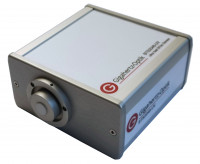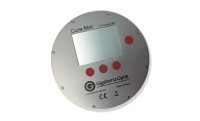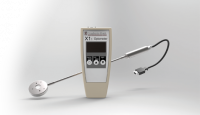This product is no longer manufactured. Remaining stock may still be available. Please refer to the alternatives listed below under "Similar products" or contact us directly.
Alternative Products for this discontinued product:
BTS256-UV
Hand-held Portable UV Spectroradiometer with Innovative Stray Light Correction for Precise Irradiance and Dose Measurement in e.g. UV Curing Applications
- Large Wavelength range 200 nm to 525 nm
- Low height with 12 mm ideal for Conveyor Belt
- Designed for high UV radiation and temperature through stainless steel housing
- Electromechanical aperture for automated offset compensation and innovative stray light correction
- Traceable calibration with ISO 17025 option
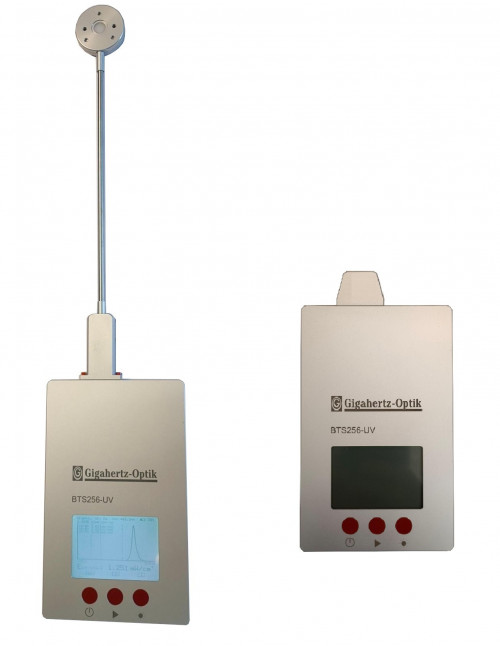
High Intensiy UV Measurement Applications
Typical applications for high-intensity radiation sources in the ultraviolet and blue spectral range are UV radiation curing, solar simulation, UV sterilization, UV test systems, and UV sewer rehabilitation. For process-based applications with repetitive measurement tasks, broadband radiometers such as the X1-RCH-116 LED UV Curing Meter are generally the most effective solution because of their ease of use, value for money, and low re-calibration cost.
UV Spectroradiometer vs. UV Broadband Radiometer
Spectroradiometers such as the BTS256-UV are an alternative to broadband radiometers that provide additional information about the spectral distribution of radiation sources. The spectral information is particularly important if the wavelength-dependent aging behavior of broadband UV lamps must be investigated or if the irradiance must be measured in different wavelength ranges. This is also important if sources of differing spectral distribution must be measured. For this purpose, broadband radiometers ideally require separate calibration factors that take these spectral differences into account. This is not necessary with spectroradiometers. In addition, spectroradiometers offer more precise measured values than broadband radiometers. This is due to their spectral sensitivity function which corresponds to a rectangular function in the selected spectral measuring range. For precise measurements in the UV spectral range, very good stray-light rejection is necessary, which is not provided by the array spectrometers typically available on the market.
BTS256-UV Spectroradiometers Comply with the Latest Design Criteria for Spectroradiometric Measuring Instruments with Superb Stray Light Correction for a Portable Meter
Wide Spectral Sensitivity Range and Perfectly Suited for all Kind of UV Sources (LED, HMI, etc.)
The spectral sensitivity range from 200 nm to 525 nm enables the precise irradiance measurement in the ultraviolet to blue wavelength range. Even the long-wave spectral component of UVA LEDs, which typically range up to approximately 490 nm, is completely captured. In particular, applications in UV or Blue Light curing and trends in the use of shortwave LEDs down to the UVC range are supported with this wide spectral range.
Cosine Field of View (f2) and Flat Design
When measuring extended light sources, correct measurement of the angle-dependent irradiance requires a cosine corrected field of view function of the instrument. In addition, the distance of the sensor to the irradiance reference plane must be as small as possible. With a height of only 12 mm and precise cosine field of view (low f2), the BTS256-UV measuring instruments are among the thinnest spectroradiometers on the market that are suitable for the precise measurement of absolute irradiance.
Stray Light Correction and Automated Dark Signal Subtraction
Stray light and dark signal both have a significant influence on measurement results of UV spectroradiometers with CCD or CMOS array sensors. Stray light is always critical if the emission spectrum of UV lamps has a long-wave component (VIS to IR), which leads to stray light in the actual measuring range of the device. The intensity of stray light in the UV range can easily exceed the intensity of the actual measurement signal and thus lead to considerable measurement errors. In contrast, dark signals are caused by operating temperature fluctuations during hand-held use and by the variation of integration times required for the measurement of differing irradiance levels.
Despite their very flat design, BTS256-UV spectroradiometers incorporate innovative stray light correction with an integrated optical filter as well as a dark level shutter as standard. Both functions are automated. This guarantees precise irradiance measurements of different emitter types and over varying operating temperatures.
Robust against Intense UV Radiation and High Temperature
In practice, spectroradiometers are often exposed to the high intense UV radiation and temperature effects that is supposed to trigger aging effects or crosslinking processes in an application. The BTS256-UV spectroradiometers are built into a stainless steel housing that has excellent UV stability and low thermal conductivity to protect the electronics. At the same time, the stability of the wavelength and irradiance readings of the meter is ensured.
Portable Hand-held UV Spectroradiometer and Process Flow Meter (Conveyor Belt)
With the BTS256-UV-1 hand-held meter, the sensor entrance optic is placed 250 mm away from the main meter. As such, it can be positioned in front of the radiation source without exposing the operator to hazardous levels of UV radiation. The sensor itself is extremely flat with an overall height of 8 mm. The calibration of the BTS256-UV-1 is carried out over a wavelength range of 225 nm - 525 nm.
With the BTS256-UV-2 flow meter, the sensor is attached directly to the meter. As such, it is ideal for UV systems where samples pass below the UV light sources on a conveyor belt. The calibration of the BTS256-UV-2 is carried out over a wavelength range of 200 nm - 525 nm.
Fast Internal Data logger
In addition to their spectral sensor, the BTS256-UV spectroradiometers include a broadband photodiode as a second detector for fast temporal sampling. This enables a much higher data logging rate than can be reached using only the array sensor.
IEC 61215 Series UV Preconditioning Tests of PV Modules
The qualification of PV modules according to IEC 61215 series requires preconditioning with defined doses of UVA and UVB radiation. Unlike conventional radiometers, the BTS256-UV spectroradiometer enables the most accurate measurement of UVA and UVB irradiance levels irrespective of the type of UV source used. Each device is supplied with a traceable calibration certificate and is designed to operate at the required high temperature. See some further details in the application article about the IEC 61215 and IEC 61646 measurements.
Factory calibration and ISO 17025 Test Certificate
The ISO 17025 accreditated measurement laboratory of Gigahertz-Optik offers high quality, traceable factory calibrations of their BTS256-UV. Factory calibrations are handled in Gigahertz-Optik’s calibration laboratory using the same quality management procedure as per NMI accredited test measurements. NMI accredited testing measurements with an ISO/IEC/EN 17025 testing certificate are optionally available.
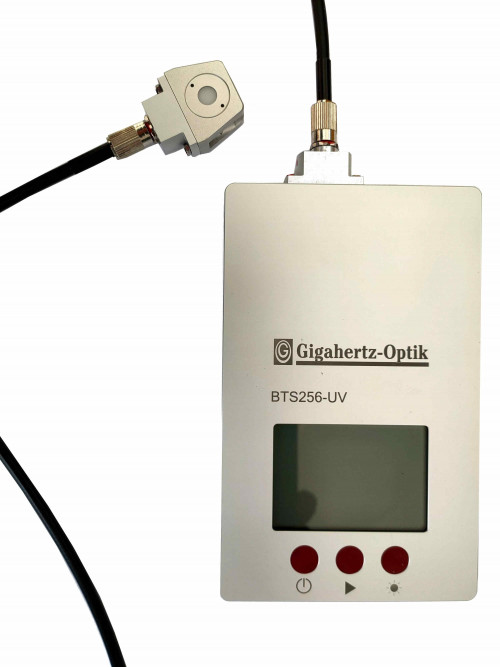
BTS256-UV-4 hand-held measuring device with flexible detector head.
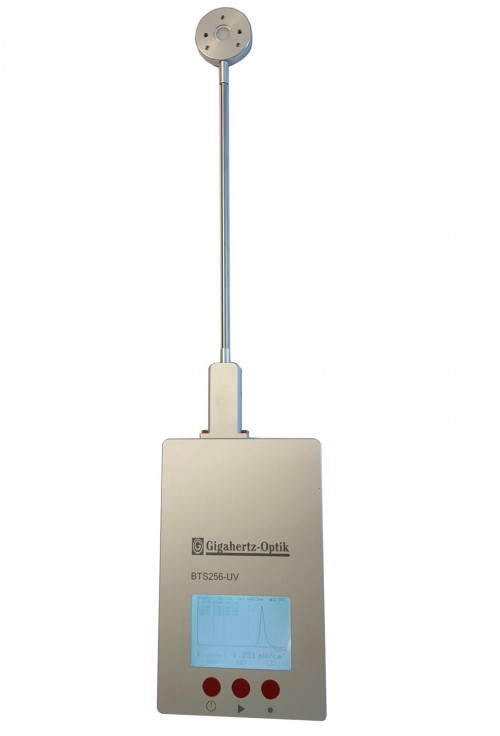
BTS256-UV-1 hand-held with safety distance to UV radiation
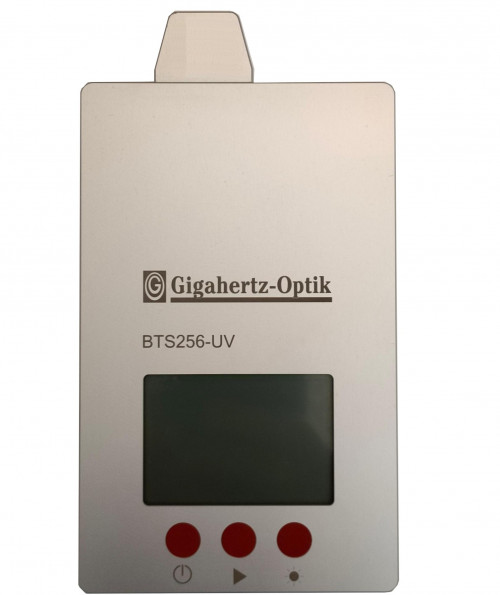
BTS256-UV-2 Continuous flow meter for use on conveyor belts
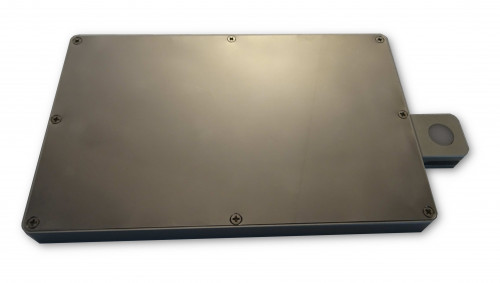
BTS256-UV-2 Continuous flow meter for use on conveyor belts / Back view
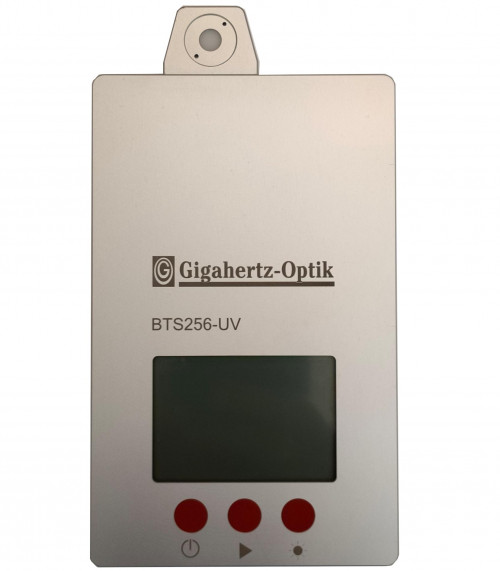
BTS256-UV-3 for measurement in direction of the upper side of device
Similar Products
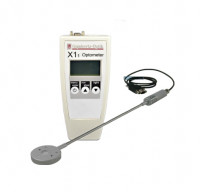
Product Categories
